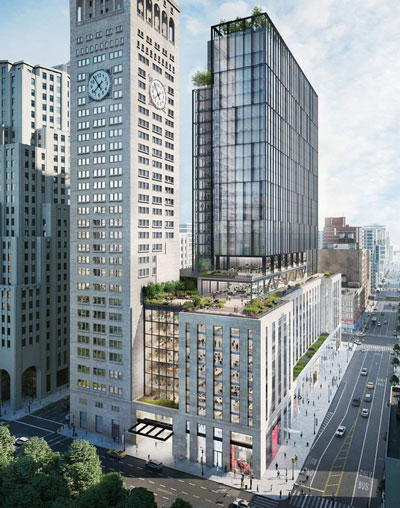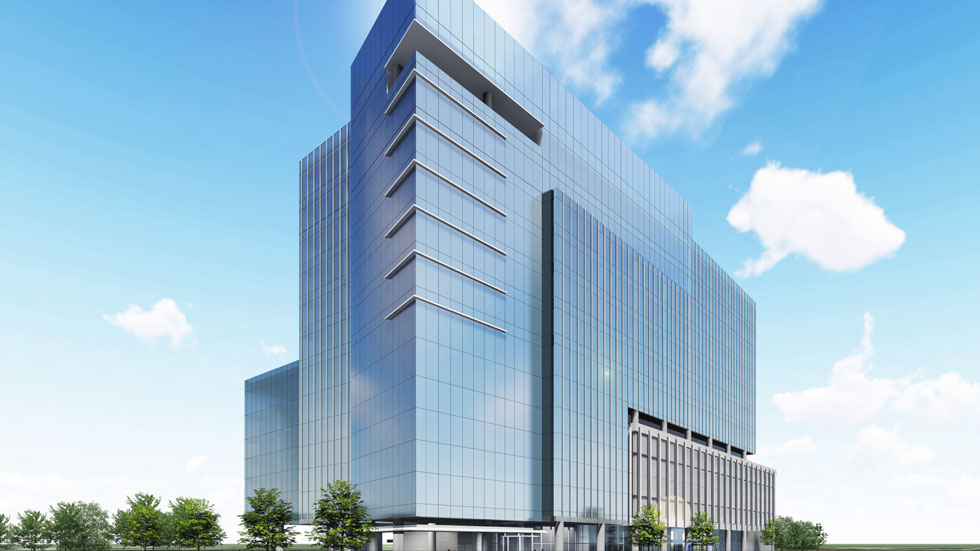The runway for REIT development continues to clear as confidence in recovery grows.
REITs that pumped the brakes on development activity last year are once again moving forward with new projects. Yet just how quickly—and firmly—REITs put their feet back on the accelerator depends on the sector and the strength of individual balance sheets.
As the scope and seriousness of COVID-19 became evident in 2020, REITs across the board took steps to conserve capital and enhance financial flexibility. In many cases, that meant putting development projects on hold that were not yet substantially underway.
“That wasn’t necessarily due to lack of opportunities caused by the pandemic, it was more REITs themselves choosing to be more conservative in their capital allocation given the very high level of uncertainty that the pandemic was creating for operations and cash flows,” says Kevin Brown, equity analyst at Morningstar.
Development is not likely to come roaring back at the flip of a switch. Construction is often more subdued following any downturn as REITs wait for markets to stabilize, or in some cases, focus their attention on more favorable buying opportunities. However, there are definite signs that activity is once again on the rise, and REITs are expected to continue to add to their pipelines through the course of 2021 as it becomes clearer that the pandemic has turned a corner.
Varied Paths
It’s no surprise that industrial REITs were among the first to pick up where they left off in their development strategies, thanks to strong demand for logistics facilities.
“The industrial sector has been extremely resilient throughout the pandemic and benefited from the e-commerce boom that has driven demand for high-quality industrial real estate in great locations,” says Steve Schnur, COO at Duke Realty Corp. (NYSE: DRE).
Like many REITs, Duke paused new speculative development at the onset of COVID-19 out of an abundance of caution. “Our development pipeline rebounded in the third quarter of 2020, and we continue to see demand for space throughout our markets,” Schnur says. In particular, Duke has ramped up its development pipeline to meet space demand in growing coastal tier one markets.
Duke’s guidance for 2021 calls for between $950 million and $1.15 billion in development starts, which is revised from its initial range of $700 million to $900 million. “Our increased guidance for development starts is based on our leasing success to-date, our solid pipeline of build-to-suit projects, and our anticipated lease up of speculative space,” Duke COO Steve Schnur adds.
The near term outlook for development varies depending on the sector, as all were impacted differently by the pandemic.
The apartment market, for example, entered the pandemic with a sizable development pipeline, and for the most part, REITs moved forward with developments that were in progress.
“Some are now actually accelerating development pipelines and are looking for more land acquisitions to seed their pipelines,” says Amanda Sweitzer, vice president and senior research analyst at Baird Equity Research.
Apartment REIT MAA (NYSE: MAA) has redirected a lot of its external growth towards new development. The company had seven projects underway as of mid-May and another two completed, accounting for almost $600 million of new development, including pre-development work underway at sites MAA already owns. MAA Chairman and CEO Eric Bolton says he expects the development pipeline to jump to about $800 million by early next year.
In the apartment sector, current thinking is that REITs can still develop at about a 6% yield, which is favorable today compared to in-place acquisitions where cap rates have continued to compress to the low 4% range or even below, Sweitzer observes. “That spread between stabilized acquisitions and new development still makes sense in apartments,” she says.
Development in sectors such as hotels, retail, and senior housing is expected to be slower to restart. Senior housing, for example, was hit hard during COVID-19. Construction starts fell dramatically over the past year and remain about 60% below where they were at the peak in the first quarter of 2018, Sweitzer notes.
“The demographic picture in senior housing is still extremely strong. So, development will restart at some point,” she says. However, developers can’t offset higher construction costs with higher assumed rents because the fundamentals are not strong enough to support that today. “So, a lot of owner-operators are focused on acquiring in-place assets where they can get attractive discounts to replacement cost today,” she says.
Growing Confidence
One thing that REITs do have in common across all sectors is growing confidence in the recovery. “For the most part, I think the runway is pretty clear of where fundamentals are going to be once the development project completes,” Brown says.
Over the past six months, many REIT executives have said that they have more confidence in 2022 numbers versus 2021 numbers, meaning that markets still could be a bit choppy in the near term but start to stabilize in 2022 and beyond.
“Once we get the country as vaccinated as much as we can and have the pandemic as under control as is possible, then there is a pretty clear path for any of these subsectors that have been negatively impacted,” Brown says.
Matthew DiLiberto, CFO at SL Green Realty Corp. (NYSE: SLG), says COVID has not had an impact on the company’s development pipeline. However,” we did have to pivot some of our corporate strategies in response to the pandemic,” he says.
For example, at the beginning of the pandemic, SL Green enacted a strategy to accumulate $1 billion in cash by the end of the second quarter of 2020. The REIT completed that plan by early June 2020, and also exceeded its financial target by nearly $200 million. “This provided us additional confidence and security to execute our strategic plans, including our development and redevelopment projects, through the pandemic,” DiLiberto says.
SL Green was ranked as one of the top 10 most active developers in the country in 2020 by Real Capital Analytics. In additional to completing the $3.3 billion One Vanderbilt in New York City in September, the company is underway on projects that include One Madison Avenue, 185 Broadway, 15 Beekman Street, and 760 Madison Avenue.
For its part, Ventas, Inc. (NYSE: VTR) restarted its ground up development as markets stabilized and the company gained a better understanding of the pandemic trajectory. Its development pipeline focuses on the key areas of senior housing and life science, and research & innovation (R&I) assets.
Ventas is continuing its investment in Le Groupe Maurice’s senior housing development pipeline in Quebec. It also is advancing ground-up development on four R&I properties containing nearly 1.5 million square feet. Through its university-based development pipeline, Ventas has another $1 billion in active potential projects in the pipeline, including The Assembly project at the University of Pittsburgh, where the former Ford assembly plant is being redeveloped into lab and office space.
Flight to Quality
Another sign that confidence is returning is a willingness to kick-off speculative projects. For example, Cousins Properties (NYSE: CUZ) broke ground on Domain 9, a speculative 334,000-square-foot office building in Austin, Texas. The project broke ground in June, marking the firm’s first new start since February 2020.
“Until recently, we didn’t add any new projects over the course of the pandemic as we evaluated COVID-19’s impact on the market, as well as monitored whether there were going to be any long-term changes to our customers’ preferences and needs as it relates to office space,” says Cousins Properties CEO Colin Connolly.
As of the first quarter, Cousins Properties development pipeline included $363 million worth of projects spanning 1.3 million square feet that is 79% pre-leased, as well as a list of land sites where the firm can build an additional 5.2 million square feet.
Some of the signs that are giving Cousins Properties confidence to move forward are major announcements from the likes of Google, Microsoft, and Oracle that they will be opening new hubs in Sunbelt cities such as Atlanta, Austin, and Dallas. Conversations the firm is having with clients also shows a continued appetite for interesting, highly amenitized, trophy office properties that will help them to attract and retain talent.
“In a market where companies are focused on bringing their talent back into the office to be together, collaborate, grow their culture and mentorship, they are focused on unique and interesting environments that will energize employees to return to work,” Connolly says.
DiLiberto at SL Green agrees. “One of our big takeaways from the pandemic is that we believe the recovery will only reinforce the flight to quality and the importance of having a portfolio concentrated in properties that have been recently developed or redeveloped.” SL Green was executing on that vision long before COVID, he says, “but now it’s even more important and our strategy to dispose of mature assets and invest in new development looks more prescient than ever.”
Duke, meanwhile, broke ground on a speculative 501,224-square-foot distribution facility in its Miami 27 Business Park in Medley, Florida in May.
Putting Dry Powder to Work
REITs came into the pandemic with strong balance sheets and were well positioned due to proactive liability management that included lowering leverage and refinancing debt well ahead of maturities. Many also had full access to lines of credit.
Early on, REITs were focused on maintaining those strong balance sheets and conserving capital because there was uncertainty, not only on their tenants’ ability to pay rent, but also their willingness to pay in some circumstances, says Stephen Boyd, senior director, U.S. real estate and leisure at Fitch Ratings. “So, it made sense to get more conservative and hold onto capital wherever they could,” he says.
Now REITs are putting that capital to work. “For most REITs, development and redevelopment is a superior risk-adjusted return for their capital than acquisitions. So, I do think you are seeing REITs reinvigorating their pipelines, but with some caveats,” Boyd says.
In the office sector, for example, where stocks are still trading at a discount to net asset value (NAV), it’s challenging for REITs to develop on balance sheet and issue equity consistent with their financial policies. As such, there is an increased use of joint ventures to help fund developments, or the sale of stabilized properties into joint ventures as a way to raise equity at more attractive prices, Boyd adds.
Ventas is funding developments both on balance sheet and through value added partnerships. Ventas created a new joint venture partnership with GIC in 2020 that covers four R&I development projects currently in progress and may be expanded to over $2 billion with other pre-identified future R&I development projects currently in its pipeline.
“Our institutional investment capital management platform continues to grow and succeed with nearly $4 billion in assets under management,” says Bob Probst, CFO at Ventas.
Traditionally, the model for the larger rated REITs is to fund development on their lines of credit or with their corporate balance sheet. As they deliver those developments, they will issue longer term debt or in some cases additional equity or permanent financing. In some cases, particularly in office, REITs might use non-recourse construction financing.
After-market equity programs, Boyd says, have been “a nice balance sheet management tool for REITs that let them incrementally fund developments with equity along the way. So, they don’t have to wait until the end when their equity price might be down.” At the same time, REITs don’t have to take the earnings dilution hit all up front by issuing the full amount of equity that they would put on the project. So, they can match funding requirements with the equity issuance consistent with financial policies a little bit better, he says.
Rising Costs
As development resumes, REITs are facing challenges that include rising costs for construction materials, labor, and land, as well as difficulty finding development sites in land-constrained markets.
Duke Realty Corp. (NYSE: DRE) CEO Jim Connor notes that that steel prices have risen about 150% since January, and lead times for steel orders have increased. “It will continue to be a challenge for the foreseeable future,” he says. Lumber prices are also up dramatically, while land prices in some cases are three times higher than what Duke was paying two or three years ago, he notes.
In some development projects, Duke COO Steve Schnur says, Duke has been in front of these issues by ordering materials in advance and locking in pricing. The REIT also tries to anticipate cost increases and include these amounts in our estimates, he says .
Duke has found that rent growth has been strong enough to more than offset the cost increases. Extended delivery schedules, which in some instances are as long as eight to 12 weeks, are negatively impacting construction schedules more than price increases, Schnur says. “We make sure our customers are aware of any potential delays so that there are no surprises when it comes to the delivery timetable,” he adds.
At Ventas, Inc. (NYSE: VTR), all of the projects currently underway are under guaranteed maximum price contracts where the pricing has been locked in for the overall project. So, there is very little raw material cost risk to these projects,” CFO Bob Probst says. For its pipeline projects, Ventas continues to monitor pricing closely and mitigate risk by building in appropriate escalation and contingencies.
Yet the combination of rising construction costs and rising interest rates could make some projects less attractive. “Deals may not pencil out as they once did,” Kevin Brown, equity analyst at Morningstar, says. The risk-adjusted spread that REITs are trying to achieve may shrink to the point that the risk is not worth the return. “I think there are going to be a lot of construction projects that are potentially cut if costs do continue to go up and interest rates continue to go up,” he says.
At the same time, rising costs could result in lower supply growth, which could create some added pricing power for REITs to raise rents. In addition, some in the industry believe that rising costs are being driven by temporary shortages of construction materials and labor and that costs could begin to normalize over the next year.


